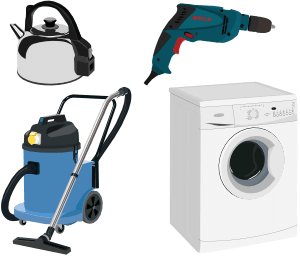Types of Electrical Equipment

The term 'Portable Appliance Testing' or 'PAT testing' often leads to confusion, with many people naturally assuming that it is only 'portable appliances' that need to be tested. The 'testing' part also implies that electrical testing is all that is required.
The process is better described as the ‘inspection and testing of electrical equipment'. All electrical equipment that is connected or could be connected, to an electrical supply should be inspected and tested. This could be a mobile phone charger, or equally, it could be a large 3-phase industrial machine. The visual inspection is also the most important part of the process. Most faults are found during the visual inspection. The inspection will also find faults that can not be detected by testing alone.
The IET categorise electrical equipment into specific types. The distinctions between the types of electrical equipment are mainly used to determine inspection and test frequencies, but they also affect some of the tests and test limits.
Portable - A portable appliance is defined as are anything that is less than 18kg that is intended to be moved, or can easily be moved, whilst in operation. So for example a kettle is a portable appliance.
Hand-held - Hand-held appliances are designed to be held in the hand during normal use. For example a hair dryer, iron or drill. Hand-held appliances are considered high risk as they are more likely to be dropped and damaged. They are often moved between different environments, each with varying degrees of risk. The consequences of an electrical shock are likely to be severe as the fault current will often travel through both arms and pass through the heart. If the fault current is above the let-go threshold, around 22 mA for most adults, the muscles in the hand will contract, making it impossible to let go of the faulty appliance.
Moveable - Moveable equipment is less than 18kg and not fixed, or has wheels or castors to allow easy movement from one place to another. The distinction between portable and moveable equipment types is not always clear. For example a toaster is portable, but a microwave that is not often, or easily moved, would be classed as moveable. Moveable equipment is sometimes also referred to as transportable.
Stationary - Equipment such as fridges, washing machines, vending machines etc., that are more than 18kg and not easily moved are classed as stationary. Because stationary appliances are rarely moved they are less likely to suffer damage so the frequency of testing required would normally be less than a hand held appliance for example.
Fixed - This is equipment that is securely fastened in place, for example a storage heater fixed to the wall. Other equipment types can also be classed as fixed when they are permanently connected to the supply via a fuse spur. For example a kettle in a hotel room connected via a fuse spur, rather than a 13A plug.
Built-in - This is equipment is often found in kitchens and is designed to be built into a cupboard, e.g. a built in cooker. The appliance usually relies on the sides of the cupboard to provide additional protection against electric shock and should therefore not be used unless installed in a suitable recess.
IT - Computers, printers etc.
If you're interested in learning more about Portable Appliance Testing, we offer comprehensive PAT testing courses that will give you the knowledge and skills you need to conduct inspections and testing effectively. Our courses cover everything from visual inspections to electrical testing. We'll ensure that you're equipped with the necessary practical skills to identify different appliance types, apply the required tests, and interpret test results. With our training, you'll be competent to carry out the inspection and testing in your workplace.